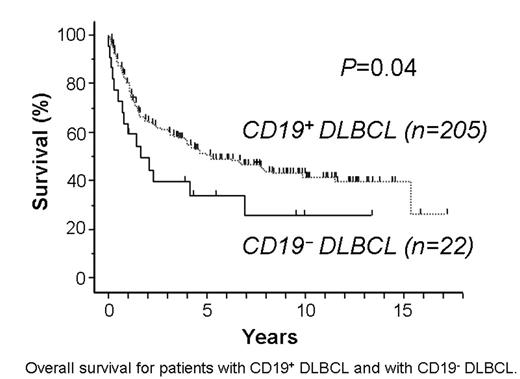Abstract
CD19 is one of the most representative B-cell markers, and is widely used in diagnostic immunophenotyping in diffuse large B-cell lymphoma (DLBCL). However, it is known that the frequency of CD19 expression in DLBCL is less than that of CD20, and the clinical significance of CD19 expression has not yet been thoroughly examined. To clarify the clinical behavior of CD19-negative (CD19−) DLBCL, we have compared the clinical features, immunophenotype, and prognosis in relation to CD19 expression. The diagnosis of DLBCL was made according to the WHO Classification. We examined CD19 expression by means of immunohistochemistry using frozen sections with a monoclonal antibody, Leu12 (Becton Dickinson). Between 1987 and 2002, 227 cases of de novo DLBCL were examined the expression of CD19 in our laboratory. Anthracycline-containing chemotherapies were selected as the first-line treatment in 192 cases (85%). None was treated with rituximab. CD19 was expressed in 205 cases (90%), and 226 cases (99%) were positive for CD20. In 22 cases of CD19-negative (CD19−) DLBCL, the median age was 63 (39–79), and the male/female ratio was 11/11. According to CD19 expression, our DLBCL cases showed the following clinical features: male/female (CD19+ DLBCL 111/94, CD19− DLBCL 11/11: NS), age>60 (70%, 55%: NS), PS>1 (20%, 36%: P=0.07), sLDH>1xN (44%, 73%: P=0.01), extranodal involvement>1 site (12%, 18%: NS), stage III/IV (41%, 54%: NS), B symptom present (29%, 45%: NS). CD19− DLBCL expressed BCL2 protein less frequently than CD19+ DLBCL (P=0.03). The expression of CD5, CD10, CD21, BCL6, and MUM1 did not show a significant difference between CD19+ DLBCL and CD19− DLBCL. CD19− DLBCL showed significantly worse survival than CD19+ DLBCL (P=0.04, log-rank test). These findings suggest that the loss of CD19 expression in DLBCL is associated with high serum LDH level and poor prognosis. Simultaneous examination of CD19 and CD20 in diagnosis of DLBCL is recommended.
Overall survival for patients with CD19+ DLBCL and with CD19− DLBCL.
Overall survival for patients with CD19+ DLBCL and with CD19− DLBCL.
Author notes
Corresponding author


This feature is available to Subscribers Only
Sign In or Create an Account Close Modal